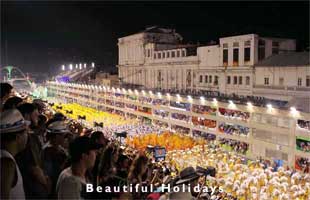Rio de Janeiro Hotels & Holidays
Brazil, South America

This coastal city is famous for its beaches, the beauty of its natural setting, and the famous statue of Christ the Redeemer that perches over the city. The city's Carnival celebrations in the run up to the forty days of Lent draw visitors from all over the world, and if you can find a hotel booking during the festivities, it would be worth the expense to spend this holiday here. Rio's beaches are also known around the world.
Rio de Janeiro Holidays Planner
People from Rio call themselves Cariocas and the city is also known as Cidade Maravilhosa or Marvellous City. The city is known for its music, the samba and the bossa nova, and there are various schools where people can go and learn these complicated dance routines. During Carnival, top students of local samba schools are chosen to head parades in merrymaking for the events leading up to the forty days of penance for Lent.
Another famous festival in Rio is New Year's, and the place to celebrate this event is Copacabana Beach. On New Year's, white-clad celebrants crowd the beach to usher in the New Year and watch the fireworks being launched just offshore.
In the city, there are the beaches of Copacabana, Ipanema, Leblon, and Barra da Tijuca for sun worshippers to lounge on and rub shoulders with Cariocas on the beach. The climate is classified as tropical savannah, and the summer season falls between December and March, making this the busy season to visit.
In the centre of Rio is Tijuca National Park, this mountainous rainforest in the city was planted in the 19th century to protect the water supply. In the middle of the park is Corcovado Mountain, whose summit is often shrouded in mist and where the statue of Christ the Redeemer is located. Visitors can climb the mountain to the foot of the statue, and there is also a waterfall in the park.
Another famous mountain in Rio is Sugarloaf Mountain. Rather than a difficult hike, visitors can ride a cable car up to the summit of this 390 foot granite mountain for a view of the sprawling city below.
In the city you can find the Arcos da Lapa, a Roman-style aqueduct built around 1750. It has been adapted to hold a tram which takes passengers into the picturesque neighbourhood of Santa Teresa. Here travellers can explore narrow winding streets that are popular with both artists and tourists. A notable venue is the home of Raimundo Otoni, an art collector's mansion that has been converted into a museum which holds works by artists like Matisse, Picasso, and Monet.
About two hours drive and a ferry ride from Rio is Ilha Grande, an island off the coast that is worth a visit if you happen to be in the area. It is beautiful, both rugged and lush, and is great for bird watchers and wildlife enthusiasts who may be able to spot sloths, howler monkeys, and caimans. The main town is Abraoo, and other wildlife that visitors may encounter include penguins and southern right whales. You will have to leave your car on the mainland, however, as the island is off-limits to vehicles.



